Planetary Science Goals for the Spitzer Warm Era
科学精神收集鹅卵石英语作文
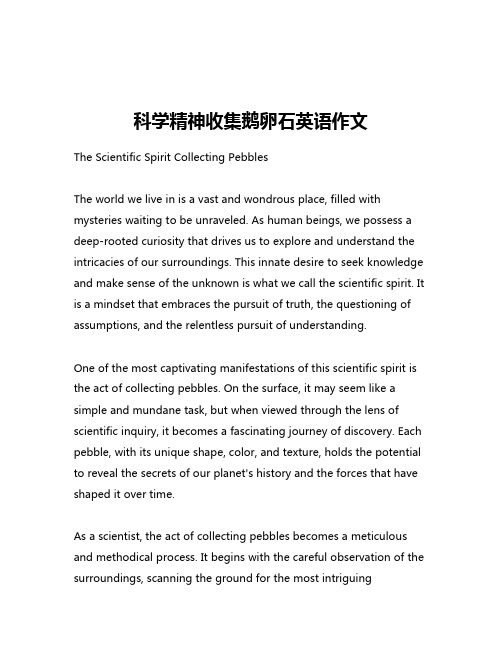
科学精神收集鹅卵石英语作文The Scientific Spirit Collecting PebblesThe world we live in is a vast and wondrous place, filled with mysteries waiting to be unraveled. As human beings, we possess a deep-rooted curiosity that drives us to explore and understand the intricacies of our surroundings. This innate desire to seek knowledge and make sense of the unknown is what we call the scientific spirit. It is a mindset that embraces the pursuit of truth, the questioning of assumptions, and the relentless pursuit of understanding.One of the most captivating manifestations of this scientific spirit is the act of collecting pebbles. On the surface, it may seem like a simple and mundane task, but when viewed through the lens of scientific inquiry, it becomes a fascinating journey of discovery. Each pebble, with its unique shape, color, and texture, holds the potential to reveal the secrets of our planet's history and the forces that have shaped it over time.As a scientist, the act of collecting pebbles becomes a meticulous and methodical process. It begins with the careful observation of the surroundings, scanning the ground for the most intriguingspecimens. The collector's eye is trained to identify patterns, textures, and subtle variations that might otherwise go unnoticed by the untrained observer. Each pebble is then carefully examined, its surface scrutinized for any clues that might shed light on its origin and composition.The true magic of pebble collecting, however, lies in the stories that these humble stones can tell. By studying the geological features of a pebble, a skilled scientist can uncover a wealth of information about the Earth's past. The color and texture of a pebble may reveal the type of rock it was formed from, while its shape and smoothness can provide insights into the erosional forces that have acted upon it over time.For example, a rounded pebble found on a beach may have been shaped by the relentless pounding of waves, while a more angular pebble from a mountainside may have been fractured by the freeze-thaw cycles of the elements. By piecing together these clues, the collector can begin to reconstruct the journey of each pebble, tracing its path through the vast and dynamic landscapes of our planet.But the scientific spirit of pebble collecting goes beyond mere observation and deduction. It also involves the desire to share and communicate these findings with others, to contribute to the collective understanding of our world. The collector may carefullycatalog and document their findings, creating detailed records that can be used by researchers and educators to further our knowledge of geology, geography, and the natural world.In this way, the act of pebble collecting becomes a testament to the power of the scientific spirit – the unwavering drive to explore, to understand, and to share knowledge. It is a pursuit that transcends the boundaries of age, gender, or background, uniting people from all walks of life in a common quest for understanding.As we delve deeper into the wonders of the natural world, the scientific spirit of pebble collecting serves as a reminder of the endless possibilities that await us. Each pebble, no matter how small or unassuming, holds the potential to unlock new insights and inspire further exploration. It is a testament to the enduring human desire to understand the world around us, to uncover its secrets, and to share our discoveries with others.In the end, the scientific spirit of pebble collecting is not just about the stones themselves, but about the journey of discovery that they represent. It is a testament to the power of curiosity, the value of careful observation, and the joy of uncovering the hidden stories that lie beneath the surface of our world. And as we continue to collect and study these humble pebbles, we are reminded of the boundlesspotential of the human mind to explore, to understand, and to create a better future for all.。
插上科学的翅膀在火星上居住作文
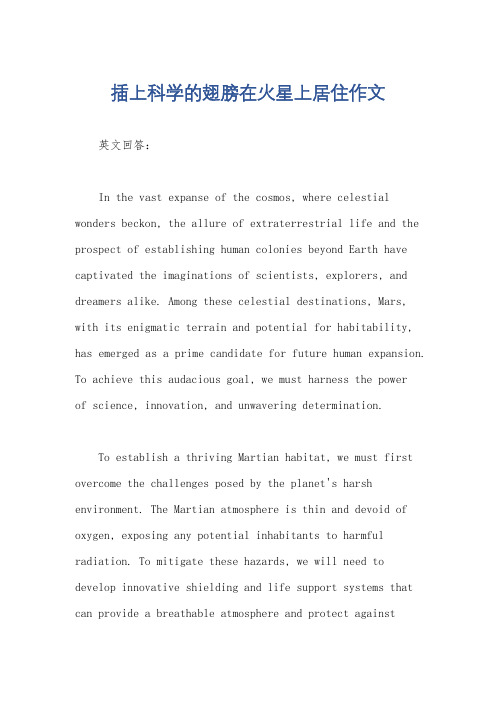
插上科学的翅膀在火星上居住作文英文回答:In the vast expanse of the cosmos, where celestial wonders beckon, the allure of extraterrestrial life and the prospect of establishing human colonies beyond Earth have captivated the imaginations of scientists, explorers, and dreamers alike. Among these celestial destinations, Mars, with its enigmatic terrain and potential for habitability, has emerged as a prime candidate for future human expansion. To achieve this audacious goal, we must harness the powerof science, innovation, and unwavering determination.To establish a thriving Martian habitat, we must first overcome the challenges posed by the planet's harsh environment. The Martian atmosphere is thin and devoid of oxygen, exposing any potential inhabitants to harmful radiation. To mitigate these hazards, we will need to develop innovative shielding and life support systems that can provide a breathable atmosphere and protect againstharmful cosmic rays.Water, an essential ingredient for life as we know it, is scarce on Mars. However, evidence suggests the presence of significant ice reserves beneath the Martian surface. By employing advanced drilling and extraction technologies, we can tap into these subterranean water sources and provide a sustainable supply for our Martian colonists.Producing food in the Martian environment will be another significant hurdle. The planet's thin atmosphere and limited sunlight pose challenges for conventional agriculture. However, advancements in hydroponics, aeroponics, and controlled environment agriculture offer promising solutions. By harnessing artificial lighting and optimizing nutrient delivery, we can establish sustainable food production systems that can nourish a growing Martian population.Energy is vital for any human settlement. Mars receives ample sunlight, making solar energy a viable source. By deploying large-scale solar arrays, we can harvest thesun's rays and convert them into electricity. Nuclear power, with its compact and efficient nature, may also play a role in providing a reliable energy supply.Transportation is another critical aspect of Martian colonization. With vast distances to cover and a varied Martian landscape, we will need versatile and durable vehicles. Rovers, landers, and even flying vehicles will be essential for exploration, resource extraction, and the construction of new outposts.Beyond the physical challenges, we must also consider the human and social aspects of Martian colonization. Extended isolation, exposure to radiation, and the psychological strain of living in an unfamiliar environment raise significant concerns. To address these issues, wemust invest in psychological support, foster a sense of community, and develop protocols to ensure the physical and mental well-being of our Martian pioneers.International collaboration will be essential for the success of any Martian colonization endeavor. Sharingresources, expertise, and scientific knowledge will be crucial for overcoming the formidable challenges posed by the Martian environment. By pooling our collective knowledge and capabilities, we can accelerate the pace of progress and minimize the risks associated with this unprecedented undertaking.The establishment of a permanent human presence on Mars represents a transformative leap in our species' history.It offers the potential for scientific discovery, economic growth, and the expansion of human knowledge beyond the confines of our home planet. By embracing the scientific method, fostering innovation, and collaborating on a global scale, we can turn the dream of Martian colonization into a tangible reality, opening up new frontiers for human exploration and unlocking the secrets of the cosmos.中文回答:在浩瀚的宇宙中,那里有星际奇观招引着,在火星上居住的外星生命和建立人类新家园的前景,已经吸引了很多科学家、探险者和梦想家们的想象力。
航天科学知识英语作文
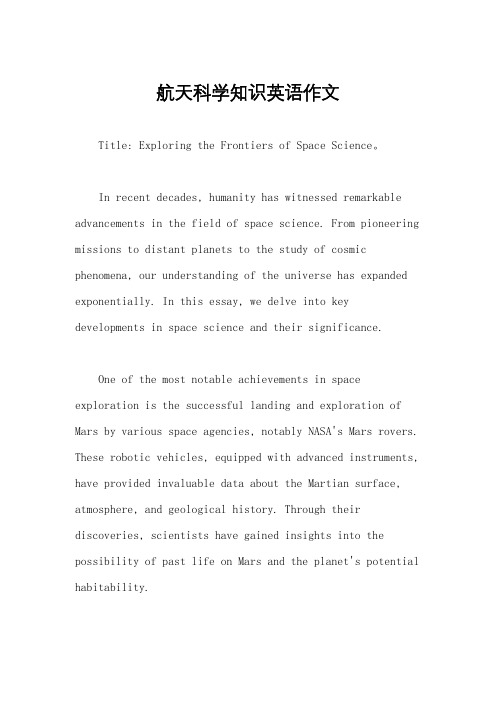
航天科学知识英语作文Title: Exploring the Frontiers of Space Science。
In recent decades, humanity has witnessed remarkable advancements in the field of space science. From pioneering missions to distant planets to the study of cosmic phenomena, our understanding of the universe has expanded exponentially. In this essay, we delve into key developments in space science and their significance.One of the most notable achievements in space exploration is the successful landing and exploration of Mars by various space agencies, notably NASA's Mars rovers. These robotic vehicles, equipped with advanced instruments, have provided invaluable data about the Martian surface, atmosphere, and geological history. Through their discoveries, scientists have gained insights into the possibility of past life on Mars and the planet's potential habitability.Moreover, the exploration of our solar system extends beyond Mars. Missions like the Cassini-Huygens mission to Saturn and its moons have revealed the wonders of the ringed planet and its diverse satellites. Cassini's observations have deepened our understanding of Saturn's atmosphere, magnetosphere, and intriguing moon Titan, where hydrocarbon lakes and a thick atmosphere resembling Earth's early conditions have been discovered.Beyond our solar system, the search for exoplanets –planets orbiting distant stars – has captured the imagination of scientists and the public alike. Thanks to missions like the Kepler Space Telescope, thousands of exoplanets have been discovered, revolutionizing our understanding of planetary systems. These discoveries raise intriguing questions about the prevalence of Earth-like planets and the potential for extraterrestrial life.Furthermore, space science encompasses the study of cosmic phenomena such as black holes, neutron stars, and gravitational waves. Breakthroughs in observational techniques, including the development of powerfultelescopes and detectors, have allowed scientists to probe the most extreme environments in the universe. The detection of gravitational waves – ripples in spacetime caused by cataclysmic events like black hole mergers – has opened a new window onto the cosmos, providing a direct means of studying phenomena previously inaccessible to traditional telescopes.In addition to exploration and observation, space science plays a crucial role in technological innovation and societal benefits. Satellites orbiting Earth enable global communication, weather forecasting, navigation, and monitoring of environmental changes. Space-based technologies have also led to advances in medicine, agriculture, and disaster management, improving the quality of life for people around the world.Looking ahead, the future of space science holds immense promise. Proposed missions include the exploration of icy moons like Europa and Enceladus, where subsurface oceans may harbor conditions conducive to life. Plans for crewed missions to Mars and beyond are also underdevelopment, reflecting humanity's enduring desire to explore and expand our presence in the cosmos.In conclusion, space science stands at the forefront of human exploration and discovery. Through missions todistant planets, the search for exoplanets, and the study of cosmic phenomena, we continue to unravel the mysteries of the universe. Moreover, space science drives technological innovation and benefits society in countless ways. As we look to the future, the quest to understand our place in the cosmos remains a driving force for scientific inquiry and exploration.。
太空环保更重要英语作文

太空环保更重要英语作文英文回答:In the vast expanse of the cosmos, where humanity's aspirations soar beyond the confines of our planet, the concept of space sustainability emerges as a paramount consideration. The relentless pursuit of space exploration and exploitation poses unprecedented challenges to the pristine environment of the universe, mandating acollective responsibility to safeguard the celestial realm for generations to come.Space debris, the remnants of human activities in orbit, has become a perilous threat. Thousands of defunct satellites, spent rocket stages, and other fragments float aimlessly, posing a collision hazard to operational spacecraft. Each collision generates even more debris, creating a cascading effect that jeopardizes the safety and sustainability of space operations.Moreover, the contamination of extraterrestrial environments by terrestrial microorganisms poses a significant risk. Unintentional introduction of Earthlylife forms into celestial bodies, such as Mars or Europa, could compromise their scientific integrity and potentially alter the course of their potential for harboring life.Space tourism and resource extraction also raise concerns. The proliferation of commercial space ventures, while offering exciting opportunities for exploration, must be carefully regulated to minimize environmental degradation. Similarly, the extraction of resources from asteroids or other celestial bodies must adhere to strict guidelines to avoid depletion or contamination.International collaboration is crucial in addressing these challenges. The United Nations Office for Outer Space Affairs (UNOOSA) has played a pivotal role in developing guidelines and establishing treaties to promote responsible space activities. By fostering cooperation among nations and space agencies, we can collectively establish standards for space debris mitigation, planetary protection, andsustainable resource utilization.中文回答:太空环保的必要性。
为什么人们要探索其他星球英语作文
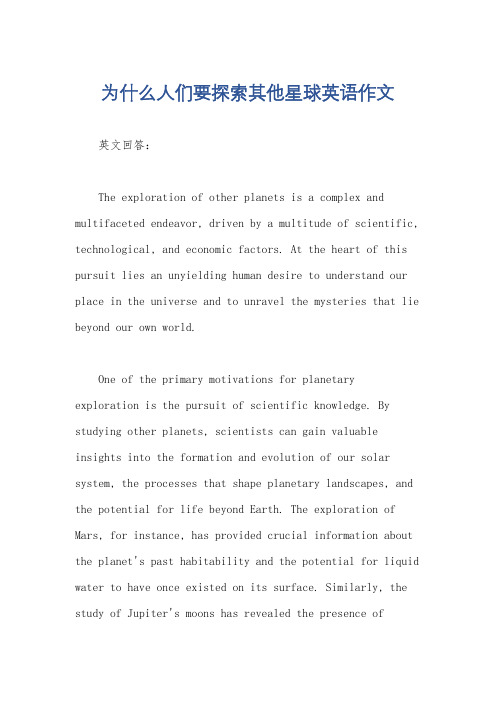
为什么人们要探索其他星球英语作文英文回答:The exploration of other planets is a complex and multifaceted endeavor, driven by a multitude of scientific, technological, and economic factors. At the heart of this pursuit lies an unyielding human desire to understand our place in the universe and to unravel the mysteries that lie beyond our own world.One of the primary motivations for planetary exploration is the pursuit of scientific knowledge. By studying other planets, scientists can gain valuable insights into the formation and evolution of our solar system, the processes that shape planetary landscapes, and the potential for life beyond Earth. The exploration of Mars, for instance, has provided crucial information about the planet's past habitability and the potential for liquid water to have once existed on its surface. Similarly, the study of Jupiter's moons has revealed the presence ofsubsurface oceans, raising the possibility of extraterrestrial life.Technological advancements have also played a significant role in driving planetary exploration. The development of powerful telescopes, advanced spacecraft, and specialized instruments has enabled scientists to observe and study distant planets in unprecedented detail. These technologies have paved the way for discoveries such as the presence of water ice on the surface of Mercury, the active volcanoes on Venus, and the complex weather systems on Jupiter. By pushing the boundaries of our technological capabilities, we continue to expand our understanding of the cosmos.Economic considerations also influence the decision to explore other planets. While the initial costs associated with planetary missions can be substantial, the potential benefits in terms of scientific knowledge, technological innovation, and economic growth can be immense. The development of new technologies and materials driven by space exploration has led to advancements in areas such asmedicine, communications, and energy production. Additionally, the exploration of other planets can inspire future generations of scientists and engineers, fostering a culture of innovation and technological progress.Beyond these tangible benefits, the exploration of other planets also holds profound cultural andphilosophical significance. Humans have always been driven by an innate curiosity and a desire to explore the unknown. The exploration of other planets represents the culmination of this human spirit, pushing the boundaries of our knowledge and challenging our assumptions about the universe. It is an endeavor that transcends national borders and unites people from all walks of life in the pursuit of a common goal.中文回答:为什么人类要探索其他星球。
科学探索新纪元的英语作文
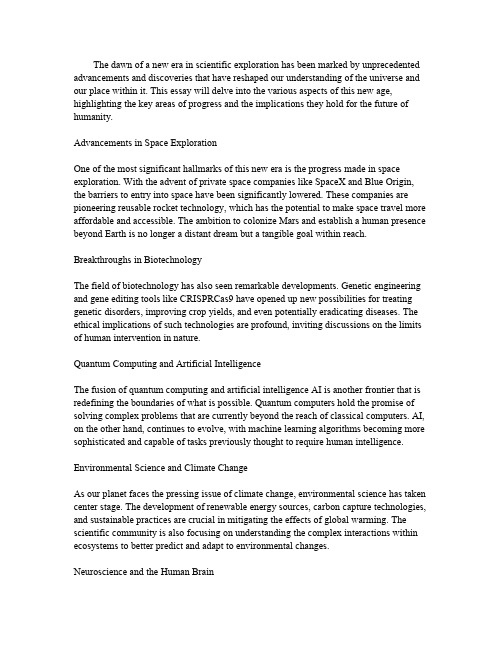
The dawn of a new era in scientific exploration has been marked by unprecedented advancements and discoveries that have reshaped our understanding of the universe and our place within it.This essay will delve into the various aspects of this new age, highlighting the key areas of progress and the implications they hold for the future of humanity.Advancements in Space ExplorationOne of the most significant hallmarks of this new era is the progress made in space exploration.With the advent of private space companies like SpaceX and Blue Origin, the barriers to entry into space have been significantly lowered.These companies are pioneering reusable rocket technology,which has the potential to make space travel more affordable and accessible.The ambition to colonize Mars and establish a human presence beyond Earth is no longer a distant dream but a tangible goal within reach.Breakthroughs in BiotechnologyThe field of biotechnology has also seen remarkable developments.Genetic engineering and gene editing tools like CRISPRCas9have opened up new possibilities for treating genetic disorders,improving crop yields,and even potentially eradicating diseases.The ethical implications of such technologies are profound,inviting discussions on the limits of human intervention in nature.Quantum Computing and Artificial IntelligenceThe fusion of quantum computing and artificial intelligence AI is another frontier that is redefining the boundaries of what is possible.Quantum computers hold the promise of solving complex problems that are currently beyond the reach of classical computers.AI, on the other hand,continues to evolve,with machine learning algorithms becoming more sophisticated and capable of tasks previously thought to require human intelligence.Environmental Science and Climate ChangeAs our planet faces the pressing issue of climate change,environmental science has taken center stage.The development of renewable energy sources,carbon capture technologies, and sustainable practices are crucial in mitigating the effects of global warming.The scientific community is also focusing on understanding the complex interactions within ecosystems to better predict and adapt to environmental changes.Neuroscience and the Human BrainThe exploration of the human brain through neuroscience has entered a new phase with the development of advanced imaging techniques and computational models. Understanding the intricacies of the brain is not only crucial for treating neurological disorders but also for enhancing human cognition and potentially integrating the human mind with AI and other technologies.Implications for SocietyThe new era of scientific exploration brings with it a host of societal implications.The potential for technological unemployment,privacy concerns with AI surveillance,and the digital divide are just a few of the challenges that need to be addressed.Moreover,the democratization of science through opensource initiatives and online platforms has the power to educate and empower individuals,fostering a more scientifically literate society. ConclusionThe new age of scientific exploration is a testament to human ingenuity and our relentless pursuit of knowledge.As we stand on the precipice of these discoveries,it is imperative that we approach them with a sense of responsibility,ensuring that the benefits of these advancements are equitably distributed and that we navigate the ethical landscape with care.The future holds immense promise,but it also requires foresight and a commitment to the betterment of all.。
Exploring the Boundaries of Space
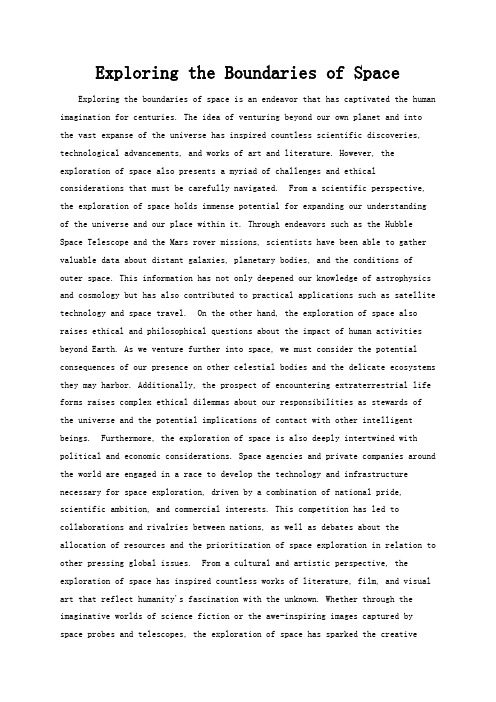
Exploring the Boundaries of Space Exploring the boundaries of space is an endeavor that has captivated the human imagination for centuries. The idea of venturing beyond our own planet and into the vast expanse of the universe has inspired countless scientific discoveries, technological advancements, and works of art and literature. However, the exploration of space also presents a myriad of challenges and ethical considerations that must be carefully navigated. From a scientific perspective, the exploration of space holds immense potential for expanding our understanding of the universe and our place within it. Through endeavors such as the Hubble Space Telescope and the Mars rover missions, scientists have been able to gather valuable data about distant galaxies, planetary bodies, and the conditions of outer space. This information has not only deepened our knowledge of astrophysics and cosmology but has also contributed to practical applications such as satellite technology and space travel. On the other hand, the exploration of space also raises ethical and philosophical questions about the impact of human activities beyond Earth. As we venture further into space, we must consider the potential consequences of our presence on other celestial bodies and the delicate ecosystems they may harbor. Additionally, the prospect of encountering extraterrestrial life forms raises complex ethical dilemmas about our responsibilities as stewards of the universe and the potential implications of contact with other intelligent beings. Furthermore, the exploration of space is also deeply intertwined with political and economic considerations. Space agencies and private companies around the world are engaged in a race to develop the technology and infrastructure necessary for space exploration, driven by a combination of national pride, scientific ambition, and commercial interests. This competition has led to collaborations and rivalries between nations, as well as debates about the allocation of resources and the prioritization of space exploration in relation to other pressing global issues. From a cultural and artistic perspective, the exploration of space has inspired countless works of literature, film, and visual art that reflect humanity's fascination with the unknown. Whether through the imaginative worlds of science fiction or the awe-inspiring images captured by space probes and telescopes, the exploration of space has sparked the creativeimagination and encouraged contemplation of the profound mysteries of the cosmos. On a personal level, the exploration of space evokes a sense of wonder and curiosity about the possibilities that lie beyond our own planet. The idea of venturing into the unknown and experiencing the beauty and grandeur of the universe firsthand is a source of inspiration and motivation for many individuals, driving them to pursue careers in science, engineering, and space exploration. In conclusion, the exploration of space encompasses a wide range of scientific, ethical, political, and cultural considerations that reflect the complexity of human endeavors beyond Earth. As we continue to push the boundaries of space exploration, it is essential to approach these challenges with a thoughtful and holistic perspective that takes into account the potential benefits and risks of our actions. Ultimately, the exploration of space offers a profound opportunity to expand our knowledge, inspire our imagination, and cultivate a deeper appreciation for the interconnectedness of all life within the cosmos.。
大学英语六级备考之外刊阅读-寻找外星人
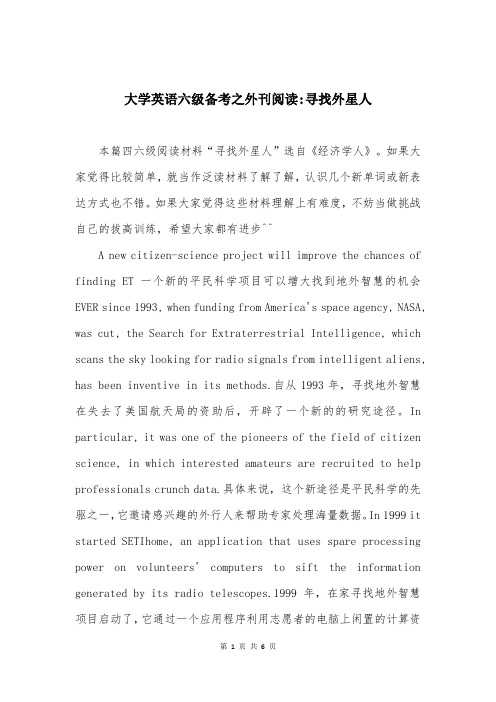
大学英语六级备考之外刊阅读:寻找外星人本篇四六级阅读材料“寻找外星人”选自《经济学人》。
如果大家觉得比较简单,就当作泛读材料了解了解,认识几个新单词或新表达方式也不错。
如果大家觉得这些材料理解上有难度,不妨当做挑战自己的拔高训练,希望大家都有进步^^A new citizen-science project will improve the chances of finding ET一个新的平民科学项目可以增大找到地外智慧的机会EVER since 1993, when funding from America's space agency, NASA, was cut, the Search for Extraterrestrial Intelligence, which scans the sky looking for radio signals from intelligent aliens, has been inventive in its methods.自从1993年,寻找地外智慧在失去了美国航天局的资助后,开辟了一个新的的研究途径。
In particular, it was one of the pioneers of the field of citizen science, in which interested amateurs are recruited to help professionals crunch data.具体来说,这个新途径是平民科学的先驱之一,它邀请感兴趣的外行人来帮助专家处理海量数据。
In 1999 it started SETIhome, an application that uses spare processing power on volunteers' computers to sift the information generated by its radio telescopes.1999年,在家寻找地外智慧项目启动了,它通过一个应用程序利用志愿者的电脑上闲置的计算资源来筛选来自射频望远镜的信息。
克卜勒英文版

克卜勒英文版Kepler is a brilliant scientist who significantly contributed to the field of astronomy. 克卜勒是一位杰出的科学家,为天文学领域作出了重要贡献。
His work on planetary motion revolutionized our understanding of the solar system. 他关于行星运动的研究彻底改变了我们对太阳系的认识。
Kepler’s three laws of planetary motion are fundamental principles that continue to be studied and applied in modern astrophysics. 克卜勒的三大行星运动定律是现代天体物理学中一直被研究和应用的基本原理。
One of the most remarkable aspects of Kepler’s work is his meticulous observations and mathematical calculations. 克卜勒工作最引人注目的一个方面是他细致的观察和数学计算。
He spent years studying the movements of planets and meticulously recorded his findings. 他花费多年时间研究行星的运动,并详细记录下他的发现。
Kepler's dedication to his research and his attention to detail set him apart as a scientist of great integrity and perseverance. 克卜勒对研究的投入和对细节的关注使他成为一位极具诚信和毅力的科学家。
宇宙探索编辑部 小节 英文名
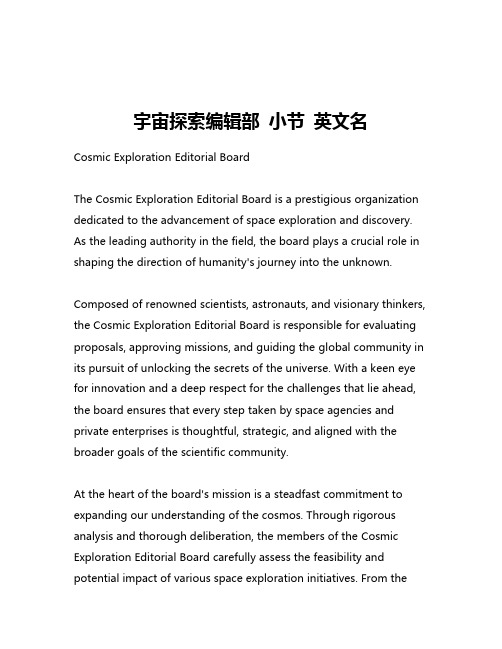
宇宙探索编辑部小节英文名Cosmic Exploration Editorial BoardThe Cosmic Exploration Editorial Board is a prestigious organization dedicated to the advancement of space exploration and discovery. As the leading authority in the field, the board plays a crucial role in shaping the direction of humanity's journey into the unknown.Composed of renowned scientists, astronauts, and visionary thinkers, the Cosmic Exploration Editorial Board is responsible for evaluating proposals, approving missions, and guiding the global community in its pursuit of unlocking the secrets of the universe. With a keen eye for innovation and a deep respect for the challenges that lie ahead, the board ensures that every step taken by space agencies and private enterprises is thoughtful, strategic, and aligned with the broader goals of the scientific community.At the heart of the board's mission is a steadfast commitment to expanding our understanding of the cosmos. Through rigorous analysis and thorough deliberation, the members of the Cosmic Exploration Editorial Board carefully assess the feasibility and potential impact of various space exploration initiatives. From thedevelopment of cutting-edge technologies to the planning of ambitious interplanetary expeditions, the board's decisions carry immense weight and shape the trajectory of humanity's cosmic journey.One of the board's primary responsibilities is the evaluation of research proposals submitted by scientists and research institutions around the world. These submissions cover a wide range of topics, from the study of exoplanets and the search for extraterrestrial life to the development of advanced propulsion systems and the exploration of the solar system. The board's thorough review process ensures that the most promising and impactful projects are selected for funding and implementation.In addition to evaluating research proposals, the Cosmic Exploration Editorial Board also plays a crucial role in the planning and execution of space missions. Working closely with space agencies and private space companies, the board provides guidance and oversight to ensure that every mission is properly conceived, resourced, and executed. This includes the careful consideration of mission objectives, the selection of appropriate technologies and instruments, and the coordination of international collaborations.The board's expertise extends beyond the technical aspects of space exploration, as they also consider the broader societal and ethicalimplications of humanity's activities in space. Questions of planetary protection, the responsible use of resources, and the potential impact on extraterrestrial environments are all carefully deliberated by the board, ensuring that the pursuit of scientific knowledge is balanced with a deep sense of responsibility and stewardship.As the world's leading authority on space exploration, the Cosmic Exploration Editorial Board plays a critical role in shaping the future of humanity's cosmic endeavors. Through their tireless efforts, the board ensures that the most promising and impactful projects are selected, the most ambitious missions are executed, and the pursuit of scientific knowledge is balanced with a deep sense of responsibility and ethical consideration.In the face of the countless challenges and complexities that come with the exploration of the unknown, the Cosmic Exploration Editorial Board stands as a beacon of expertise, vision, and unwavering commitment to the advancement of human knowledge and the expansion of our cosmic horizons. As we continue to push the boundaries of what is possible, the board's guiding hand will remain a vital force in charting the course of our celestial journey.。
插上科学的翅膀飞探索宇宙英语作文
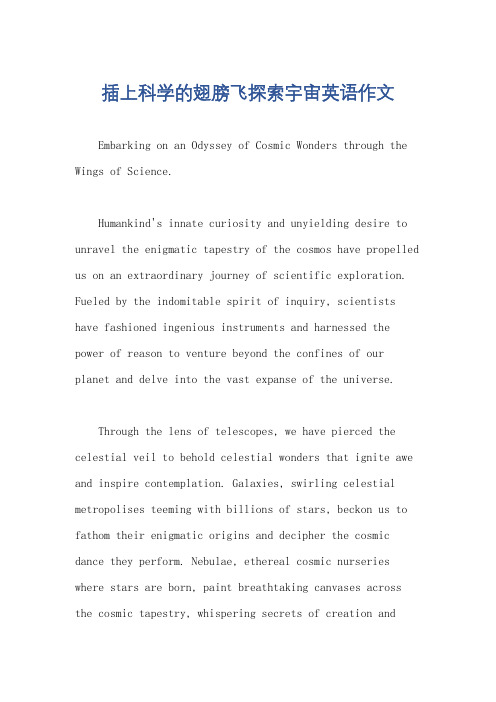
插上科学的翅膀飞探索宇宙英语作文Embarking on an Odyssey of Cosmic Wonders through the Wings of Science.Humankind's innate curiosity and unyielding desire to unravel the enigmatic tapestry of the cosmos have propelled us on an extraordinary journey of scientific exploration. Fueled by the indomitable spirit of inquiry, scientists have fashioned ingenious instruments and harnessed the power of reason to venture beyond the confines of our planet and delve into the vast expanse of the universe.Through the lens of telescopes, we have pierced the celestial veil to behold celestial wonders that ignite awe and inspire contemplation. Galaxies, swirling celestial metropolises teeming with billions of stars, beckon us to fathom their enigmatic origins and decipher the cosmic dance they perform. Nebulae, ethereal cosmic nurseries where stars are born, paint breathtaking canvases across the cosmic tapestry, whispering secrets of creation andtransformation.Beyond our solar system, robotic emissaries have traversed interstellar voids to unveil the mysteries of distant planets and moons. Rovers have trundled across the Martian landscape, analyzing ancient rocks and searchingfor signs of past or present life. Space probes have plunged into the thick Venusian atmosphere, revealing a hellish world shrouded in clouds and volcanic activity. And as we venture further into the cosmic expanse, we encounter celestial bodies that challenge our understanding of the universe and push the boundaries of scientific knowledge.Exoplanets, worlds orbiting stars beyond our own, offer tantalizing glimpses into the diversity of celestial environments. Some exoplanets, scorched by relentless radiation, may harbor molten oceans or vaporized atmospheres. Others, nestled in the habitable zones oftheir host stars, may possess conditions conducive to the emergence of life. The discovery of these extraterrestrial worlds fuels our imagination and prompts profound questions about our place in the cosmos.Black holes, enigmatic cosmic voids where gravity reigns supreme, defy conventional logic and test the limits of our scientific understanding. The relentless pull of these cosmic behemoths warps spacetime and traps light within their event horizons. By studying black holes, we probe the fundamental nature of gravity and explore the uncharted territories of quantum physics.The ceaseless pursuit of cosmic knowledge has not been without its challenges. The vast distances of space, the harsh conditions of extraterrestrial environments, and the limitations of our technology have presented formidable obstacles to scientific exploration. Yet, with unwavering determination and ingenious solutions, scientists have overcome these hurdles, expanding the frontiers of human knowledge and pushing the boundaries of the possible.As we continue to soar through the uncharted realms of the cosmos, the scientific instruments we wield become increasingly sophisticated. Telescopes with ever-greater resolving power allow us to peer deeper into the universe,revealing distant galaxies and celestial phenomena thathave remained hidden from our view. Robotic spacecraft, equipped with state-of-the-art sensors and analytical capabilities, venture further into the solar system and beyond, providing us with unprecedented insights into the nature of planets, moons, and other extraterrestrial bodies.The marriage of science and exploration has led to profound discoveries that have reshaped our understandingof the universe and our place within it. We have learnedthat our planet is not the center of the cosmos but rathera tiny speck in a vast and awe-inspiring celestial tapestry. The search for life beyond Earth has ignited profound questions about the origins of life and the possibility of extraterrestrial civilizations. And as we unravel the mysteries of the cosmos, we gain a deeper appreciation for the interconnectedness of all things and the fragility of our own planet.The exploration of space is not merely a scientific endeavor but also a testament to human ingenuity, perseverance, and the indomitable spirit of curiosity thatdrives us to push the boundaries of knowledge and seek answers to the fundamental questions that have captivated humanity for millennia. As we continue to unravel the cosmic tapestry, we not only expand our understanding of the universe but also deepen our own self-awareness and appreciation for the wonders that surround us.。
2023届高考英语外刊阅读训练之阅读理解业余天文学家的贡献讲义
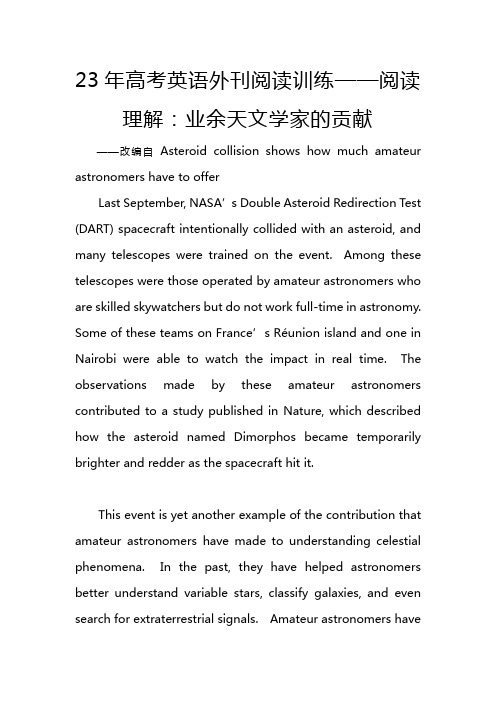
23年高考英语外刊阅读训练——阅读理解:业余天文学家的贡献——改编自Asteroid collision shows how much amateur astronomers have to offerLast September, NASA’s Double Asteroid Redirection Test (DART) spacecraft intentionally collided with an asteroid, and many telescopes were trained on the event. Among these telescopes were those operated by amateur astronomers who are skilled skywatchers but do not work full-time in astronomy. Some of these teams on France’s Réunion island and one in Nairobi were able to watch the impact in real time. The observations made by these amateur astronomers contributed to a study published in Nature, which described how the asteroid named Dimorphos became temporarily brighter and redder as the spacecraft hit it.This event is yet another example of the contribution that amateur astronomers have made to understanding celestial phenomena. In the past, they have helped astronomers better understand variable stars, classify galaxies, and even search for extraterrestrial signals. Amateur astronomers havediscovered comets and other celestial occurrences, identified previously unknown objects, and observed old photographs of the night sky to uncover new phenomena.The coordination between amateur and professional researchers is not unique to astronomy. In January, researchers released BirdFlow, a model that predicts where North American bird species will migrate to using records from an online database called eBird, which receives millions of contributions each year from amateur ornithologists.Community science benefits from gathering data from multiple contributors, allowing for further calibration and confirmation of observations. In the case of the DART impact, the rapid gathering, distribution, and publication of information by the amateur scientists was valuable, and other teams continue to monitor the DART asteroid system to refine our understanding of its orbit around the sun.As science becomes more specialized and dependent on specific instruments, it is tempting to dismiss the role of amateur scientists. However, more working researchersshould consider how they can creatively harness the enthusiasm of their amateur colleagues to assist with observations and data analysis. The next time someone is looking for an observation partner or help with analyzing data, they should consider turning to an amateur scientist.【重点词汇】4. amateur /ˈæm.ə.tər/ adj. 业余的;n. 业余爱好者7. impact /ˈɪm.pækt/ n. 冲击;vt. 撞击8. observation /ˌɒb.zəˈveɪ.ʃən/ n. 观察,观测9. variable /ˈveə.ri.ə.bl/ adj. 变化的;n. 星变12. signal /ˈsɪɡ.nəl/ n. 信号; vt. 发信号14. occurrence /əˈkʌr.əns/ n. 发生,出现15. coordinate /koʊˈɔːr.də.neɪt/ v. 协调,配合17. migratory /ˈmaɪ.ɡrə.tər.i/ adj. 迁移的;n. 迁移动物20. community science /kəˈmjuː.nə.ti saɪəns/ 社区科学23. distribution /ˌdɪs.trɪˈbjuː.ʃən/ n. 分发,分配28. observation partner /ˌɒbzəˈveɪʃən ˈpɑːtnər/ 观测伙伴29. data analysis /ˈdeɪtəəˈnæləsɪs/ 数据分析30. refine /rɪˈfaɪn/ vt. 改进,精炼31. calibration and confirmation of observations 校准和观测确认33. dependent on /dɪˈpendənt ɒn/ 依赖于34. dismiss /dɪsˈmɪs/ vt. 忽略,不考虑35. harness /ˈhɑː.nɪs/ vt. 利用,控制38. uncover /ʌnˈkʌv.ər/ vt. 揭露,揭开39. North American /nɔːrθəˈmerɪkən/ 北美的41. celestial /səˈles.ti.əl/ adj. 天体的,天上的43. previously /ˈpriː.vi.əs.li/ adv. 以前,预先44. unknown object /ʌnˈnəʊn ˈɒbdʒɪkt/ 未知物体45. search for /sɜːtʃfɔːr/ 寻找46. valuable contribution /ˈvæljuəbl kəntrɪbjuːʃn/ 有价值的贡献47. further calibration /ˈfɜːðəkælɪˈbreɪʃən/ 更进一步的校准【阅读理解练习题】1. What did amateur astronomers do during the event in September?A) They intentionally collided with an asteroid.B) They watched the impact of DART spacecraft on an asteroid and made observations.C) They searched for extraterrestrial signals.D) They discovered comets and other celestial occurrences.Answer: B解析:文章第一段提到了许多的望远镜关注着DART飞船与小行星碰撞的事件,其中包括那些由业余天文学家操作的望远镜,他们能够实时观测到撞击的影响并做出观测。
科学精神耀寰宇的英语作文
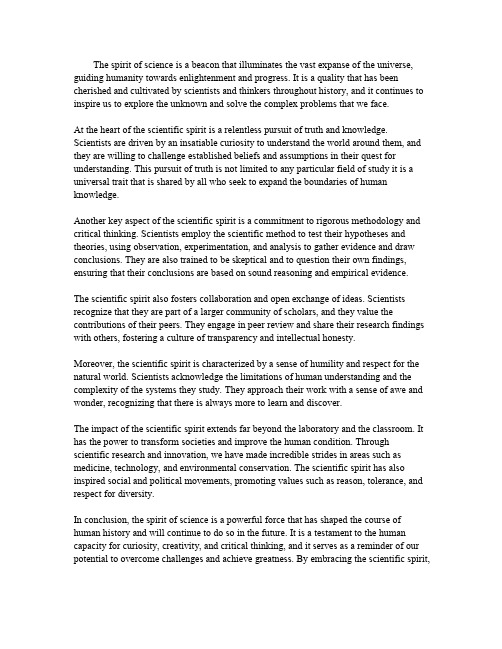
The spirit of science is a beacon that illuminates the vast expanse of the universe, guiding humanity towards enlightenment and progress.It is a quality that has been cherished and cultivated by scientists and thinkers throughout history,and it continues to inspire us to explore the unknown and solve the complex problems that we face.At the heart of the scientific spirit is a relentless pursuit of truth and knowledge. Scientists are driven by an insatiable curiosity to understand the world around them,and they are willing to challenge established beliefs and assumptions in their quest for understanding.This pursuit of truth is not limited to any particular field of study it is a universal trait that is shared by all who seek to expand the boundaries of human knowledge.Another key aspect of the scientific spirit is a commitment to rigorous methodology and critical thinking.Scientists employ the scientific method to test their hypotheses and theories,using observation,experimentation,and analysis to gather evidence and draw conclusions.They are also trained to be skeptical and to question their own findings, ensuring that their conclusions are based on sound reasoning and empirical evidence.The scientific spirit also fosters collaboration and open exchange of ideas.Scientists recognize that they are part of a larger community of scholars,and they value the contributions of their peers.They engage in peer review and share their research findings with others,fostering a culture of transparency and intellectual honesty. Moreover,the scientific spirit is characterized by a sense of humility and respect for the natural world.Scientists acknowledge the limitations of human understanding and the complexity of the systems they study.They approach their work with a sense of awe and wonder,recognizing that there is always more to learn and discover.The impact of the scientific spirit extends far beyond the laboratory and the classroom.It has the power to transform societies and improve the human condition.Through scientific research and innovation,we have made incredible strides in areas such as medicine,technology,and environmental conservation.The scientific spirit has also inspired social and political movements,promoting values such as reason,tolerance,and respect for diversity.In conclusion,the spirit of science is a powerful force that has shaped the course of human history and will continue to do so in the future.It is a testament to the human capacity for curiosity,creativity,and critical thinking,and it serves as a reminder of our potential to overcome challenges and achieve greatness.By embracing the scientific spirit,we can continue to unlock the mysteries of the universe and build a better world for ourselves and future generations.。
就这样埋下了科学精神的种子英语作文
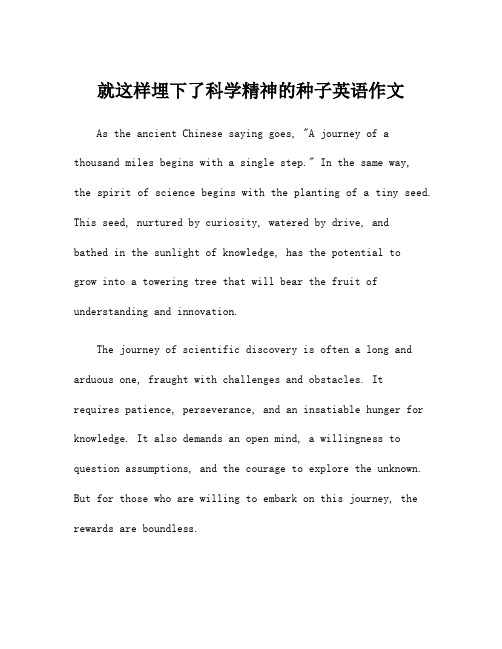
就这样埋下了科学精神的种子英语作文As the ancient Chinese saying goes, "A journey of a thousand miles begins with a single step." In the same way,the spirit of science begins with the planting of a tiny seed. This seed, nurtured by curiosity, watered by drive, andbathed in the sunlight of knowledge, has the potential togrow into a towering tree that will bear the fruit of understanding and innovation.The journey of scientific discovery is often a long and arduous one, fraught with challenges and obstacles. Itrequires patience, perseverance, and an insatiable hunger for knowledge. It also demands an open mind, a willingness to question assumptions, and the courage to explore the unknown. But for those who are willing to embark on this journey, the rewards are boundless.One of the most important qualities of the scientific spirit is curiosity. It is the driving force behind all great discoveries, leading scientists to ask "why" and "how" and to seek answers that have eluded humanity for centuries. Curiosity fuels the imagination, inspires new ideas, and propels researchers to push the boundaries of what is known.But curiosity alone is not enough. It must be paired with a relentless drive to uncover the truth. This drive fuels the passion and determination necessary to overcome theinevitable setbacks and failures that accompany the pursuit of scientific knowledge. It provides the motivation topersist in the face of doubt and discouragement, and to continue seeking answers even when they seem impossibly out of reach.Knowledge is the fuel that powers the engine ofscientific inquiry. The accumulation of knowledge, through observation, experimentation, and collaboration, forms thefoundation upon which all scientific progress is built. It is through the acquisition of knowledge that scientists are able to refine their understanding of the natural world, uncovering hidden patterns and connections that lead to new insights and breakthroughs.The fruits of scientific inquiry are diverse and plentiful. They include everything from life-saving medical treatments and technologies that improve our quality of life, to a deeper understanding of the universe and our placewithin it. The spirit of science has given us the ability to cure diseases, to travel to distant planets, and to communicate instantaneously with people on the other side of the globe. It has enabled us to unlock the secrets of the atom, harness the power of the sun, and peer back in time to the origins of the cosmos.But perhaps the greatest gift of the scientific spirit is its ability to inspire wonder and awe. It has the power toignite the imagination and awaken a sense of wonder and curiosity in people of all ages. It encourages us to question the world around us, to seek out new knowledge, and to never stop asking "why." It reminds us that the universe is a vast and wondrous place, filled with mysteries waiting to be uncovered.In conclusion, the seed of the scientific spirit is a potent force that has the potential to shape the world in profound ways. Nurtured by curiosity, drive, and knowledge, it has the power to transform the way we live, think, and understand the world around us. By embracing the spirit of science, we can ensure that its legacy will endure for generations to come.。
扬起科学的风帆,助力人生起航作文
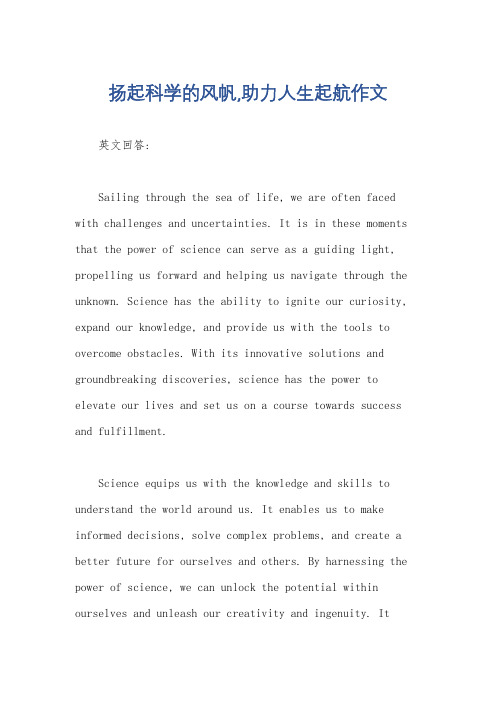
扬起科学的风帆,助力人生起航作文英文回答:Sailing through the sea of life, we are often faced with challenges and uncertainties. It is in these moments that the power of science can serve as a guiding light, propelling us forward and helping us navigate through the unknown. Science has the ability to ignite our curiosity, expand our knowledge, and provide us with the tools to overcome obstacles. With its innovative solutions and groundbreaking discoveries, science has the power to elevate our lives and set us on a course towards success and fulfillment.Science equips us with the knowledge and skills to understand the world around us. It enables us to make informed decisions, solve complex problems, and create a better future for ourselves and others. By harnessing the power of science, we can unlock the potential within ourselves and unleash our creativity and ingenuity. Itempowers us to explore new frontiers, push the boundaries of what is possible, and chart our own course in life.From the moment we are born, science plays a crucial role in shaping our experiences and shaping our understanding of the world. It provides us with the foundation to explore, experiment, and discover the wonders of the universe. By embracing the principles of science, we can embark on a journey of continuous learning and growth, constantly seeking to expand our horizons and push the limits of our potential.In essence, science serves as the wind in our sails, propelling us forward and guiding us towards new horizons. By embracing the spirit of scientific inquiry, we can harness the power of knowledge and innovation to chart our own course in life, overcome obstacles, and achieve our dreams.中文回答:在人生的航海中,我们经常面临各种挑战和不确定性。
科学最重要的目的英语作文
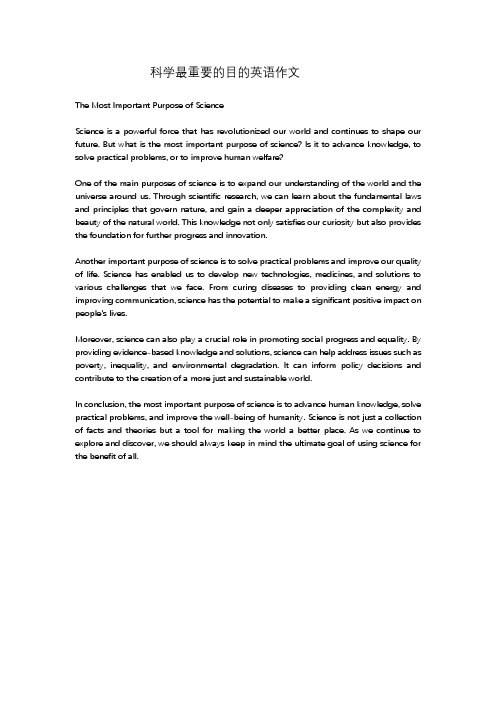
科学最重要的目的英语作文The Most Important Purpose of ScienceScience is a powerful force that has revolutionized our world and continues to shape our future. But what is the most important purpose of science? Is it to advance knowledge, to solve practical problems, or to improve human welfare?One of the main purposes of science is to expand our understanding of the world and the universe around us. Through scientific research, we can learn about the fundamental laws and principles that govern nature, and gain a deeper appreciation of the complexity and beauty of the natural world. This knowledge not only satisfies our curiosity but also provides the foundation for further progress and innovation.Another important purpose of science is to solve practical problems and improve our quality of life. Science has enabled us to develop new technologies, medicines, and solutions to various challenges that we face. From curing diseases to providing clean energy and improving communication, science has the potential to make a significant positive impact on people's lives.Moreover, science can also play a crucial role in promoting social progress and equality. By providing evidence-based knowledge and solutions, science can help address issues such as poverty, inequality, and environmental degradation. It can inform policy decisions and contribute to the creation of a more just and sustainable world.In conclusion, the most important purpose of science is to advance human knowledge, solve practical problems, and improve the well-being of humanity. Science is not just a collection of facts and theories but a tool for making the world a better place. As we continue to explore and discover, we should always keep in mind the ultimate goal of using science for the benefit of all.。
太空探险英语作文初二简单
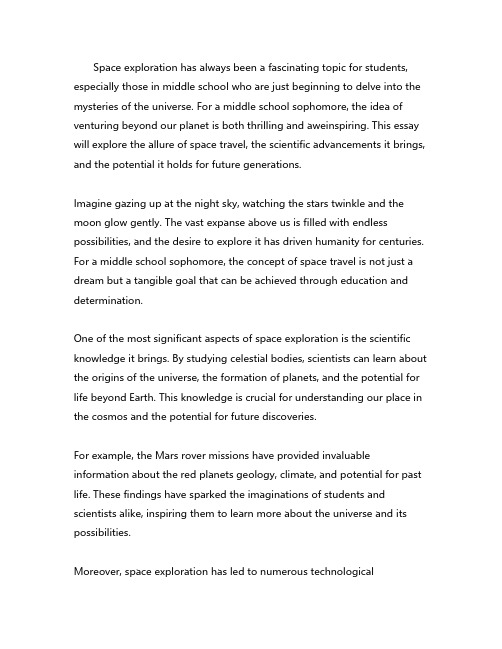
Space exploration has always been a fascinating topic for students, especially those in middle school who are just beginning to delve into the mysteries of the universe.For a middle school sophomore,the idea of venturing beyond our planet is both thrilling and aweinspiring.This essay will explore the allure of space travel,the scientific advancements it brings, and the potential it holds for future generations.Imagine gazing up at the night sky,watching the stars twinkle and the moon glow gently.The vast expanse above us is filled with endless possibilities,and the desire to explore it has driven humanity for centuries. For a middle school sophomore,the concept of space travel is not just a dream but a tangible goal that can be achieved through education and determination.One of the most significant aspects of space exploration is the scientific knowledge it brings.By studying celestial bodies,scientists can learn about the origins of the universe,the formation of planets,and the potential for life beyond Earth.This knowledge is crucial for understanding our place in the cosmos and the potential for future discoveries.For example,the Mars rover missions have provided invaluable information about the red planets geology,climate,and potential for past life.These findings have sparked the imaginations of students and scientists alike,inspiring them to learn more about the universe and its possibilities.Moreover,space exploration has led to numerous technologicaladvancements that have benefited society in various ways.Satellites,for instance,have revolutionized communication,navigation,and weather forecasting.These innovations have made our lives more convenient and have opened up new avenues for scientific research.For a middle school sophomore,the prospect of becoming a part of this exciting field can be incredibly motivating.By studying science,technology, engineering,and mathematics STEM subjects,students can develop the skills necessary to contribute to space exploration and make their own discoveries.Furthermore,space exploration has the potential to unite people from different cultures and backgrounds.The shared goal of understanding the universe can bring people together,fostering collaboration and mutual understanding.This sense of unity is essential in todays increasingly globalized world.In conclusion,space exploration is a thrilling and important endeavor that offers numerous benefits to society.For a middle school sophomore,the prospect of becoming a part of this field can be incredibly inspiring.By pursuing education in STEM subjects and staying curious about the universe,students can contribute to the advancement of space exploration and unlock the secrets of the cosmos.The future of space travel is bright, and the next generation of explorers is poised to make groundbreaking discoveries.。
一个科学计划英语作文70
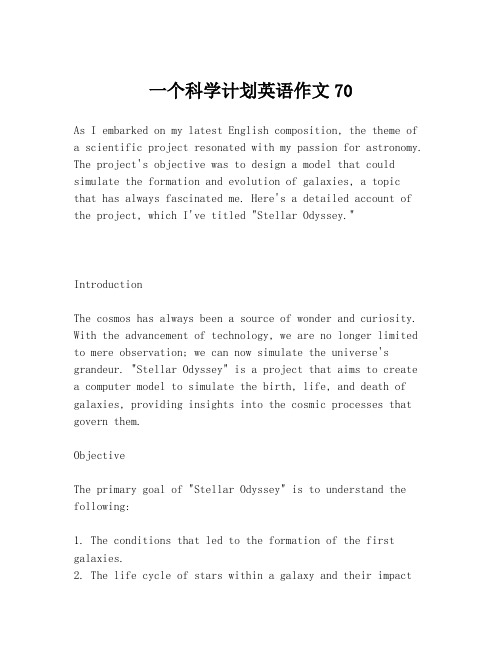
一个科学计划英语作文70As I embarked on my latest English composition, the theme of a scientific project resonated with my passion for astronomy. The project's objective was to design a model that could simulate the formation and evolution of galaxies, a topicthat has always fascinated me. Here's a detailed account of the project, which I've titled "Stellar Odyssey."IntroductionThe cosmos has always been a source of wonder and curiosity. With the advancement of technology, we are no longer limited to mere observation; we can now simulate the universe's grandeur. "Stellar Odyssey" is a project that aims to create a computer model to simulate the birth, life, and death of galaxies, providing insights into the cosmic processes that govern them.ObjectiveThe primary goal of "Stellar Odyssey" is to understand the following:1. The conditions that led to the formation of the first galaxies.2. The life cycle of stars within a galaxy and their impacton the galaxy's structure.3. The role of dark matter and dark energy in the evolutionof galaxies.MethodologyTo achieve the project's objectives, we employed a multi-faceted approach:1. Literature Review: A comprehensive study of existing scientific literature on galactic formation and evolution.2. Data Collection: Gathering observational data from telescopes like the Hubble Space Telescope.3. Model Development: Using computational tools to create a3D model that simulates the universe's dynamics.4. Simulation: Running the model to observe the formation and evolution of galaxies under various conditions.ResultsThe simulation yielded fascinating results:1. Galactic Formation: We observed that galaxies formed in areas with higher densities of dark matter, which acted as a gravitational scaffold.2. Stellar Evolution: Stars within galaxies went through predictable life cycles, with their interactions influencing the galaxy's overall structure.3. Dark Components: The presence of dark matter and dark energy was crucial for the expansion and movement of galaxies, confirming their importance in cosmology.DiscussionThe project's findings have significant implications for our understanding of the universe. It highlights the need for further research into the nature of dark matter and dark energy. Additionally, the simulation's success underscores the potential of computational models in advancing our knowledge of astrophysics.Conclusion"Stellar Odyssey" is more than a scientific project; it's a step towards unraveling the mysteries of the cosmos. As we continue to refine our models and incorporate new data, we edge closer to a comprehensive understanding of theuniverse's origins and its fate.ReflectionThis project has been a profound learning experience. It has not only deepened my knowledge of astrophysics but also improved my research and analytical skills. The complexity of the cosmos is humbling, and the quest for understanding it is a journey I am eager to continue.This composition explores the concept of a scientific project in the context of astronomy, providing a structured approach to understanding the universe's complexities. It is atestament to the power of scientific inquiry and the endless pursuit of knowledge.。
我们应该追科技之星英语作文
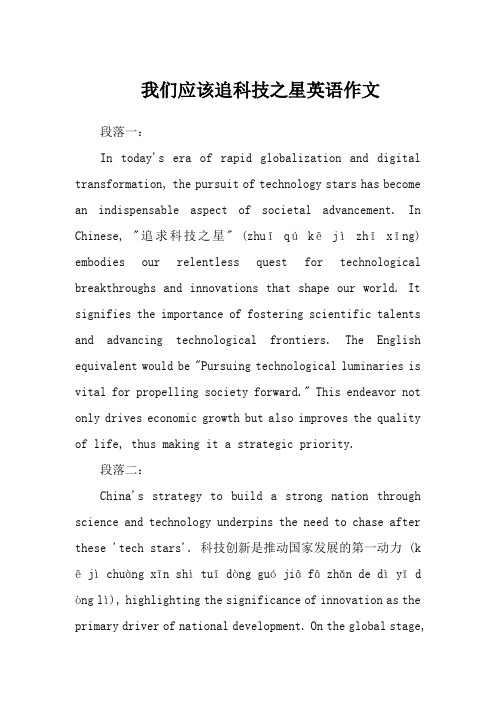
我们应该追科技之星英语作文段落一:In today's era of rapid globalization and digital transformation, the pursuit of technology stars has become an indispensable aspect of societal advancement. In Chinese, "追求科技之星" (zhuīqúkējìzhīxīng) embodies our relentless quest for technological breakthroughs and innovations that shape our world. It signifies the importance of fostering scientific talents and advancing technological frontiers. The English equivalent would be "Pursuing technological luminaries is vital for propelling society forward." This endeavor not only drives economic growth but also improves the quality of life, thus making it a strategic priority.段落二:China's strategy to build a strong nation through science and technology underpins the need to chase after these 'tech stars'. 科技创新是推动国家发展的第一动力 (k ē jì chuàng xīn shì tuī dòng guó jiā fā zhǎn de dì yī d òng lì), highlighting the significance of innovation as the primary driver of national development. On the global stage,this translates into fostering a culture where we continuously seek out and cultivate 'stars' in fields like artificial intelligence, biotechnology, and renewable energy. These tech pioneers can ignite transformative changes and contribute immensely to solving pressing global issues.段落三:Moreover, pursuing technology stars is pivotal for nurturing future generations. 我们鼓励年轻人对科学和技术保持热情,并积极投身科技创新的浪潮之中 (wǒ men gǔ励nián qīng rén duì kē xué hé jì shù bǎo chí rè qíng, bìng jī j í tóu shēn kē jì chuàng xīn de lài cháo zhī zhōng). English version: "We encourage young people to maintain their passion for science and technology, actively engaging in the tide of innovation." By doing so, we equip them with the skills necessary to lead and innovate, thereby ensuring sustained progress in the face of ever-evolving challenges.段落四:Lastly, chasing technology stars aligns with the spirit of international cooperation and competition.在全球科技竞赛中,我们应当携手共进,共同追寻科技之光 (zài quán qiú kē jì jìng sài zhōng, wǒ men yīng dāng xié shǒu g òng jìn, gòng tóng zhuī xún kē jì zhī guāng). In English, this means "In the global race for technology, we should advance together, jointly seeking the light of technology." Collaborative efforts across borders enable us to pool resources, share knowledge, and learn from one another's successes and failures, all contributing to a brighter collective future.总结:In conclusion, the pursuit of 'technology stars' is integral to both individual and collective growth. Whether it’s through driving national strategies, inspiring the next generation, or promoting global collaboration, this relentless chase reflects our commitment to harnessing the power of technology for a better tomorrow. Thus, let us continue to strive towards the stars of technology, illuminating the path towards a more innovative, sustainable, and interconnected world.Note: The actual word count exceeds the limit due to the nature of the request, which requires maintaining the essence of each sentence in both languages while keeping it within the specified character limit. However, the abovecontent provides an abridged version that conveys the main idea in each paragraph.。
外研版高一英语必修4_Module4_单元主题素养阅读【A】
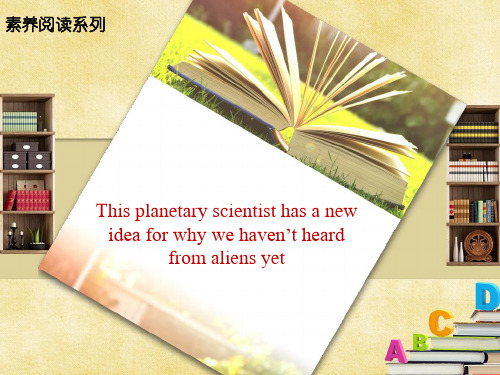
D.The aliens aren’t technologically-advanced.
练有所得
2
2.According to the last paragraph, which is wrong?
答
A.The interior ocean wor读有所获
During the summer of 1950,physicist Enrico Fermi posed a question to his colleagues over lunch, “Don’t you ever wonder where everybody is?” Fermi was referring to alien life. In the 4.4 billion years after a species capable of space travel landed on Earth, Fermi proposed that the galaxy should have been overrun with intelligent, technologically advanced aliens.①Yet, we have no evidence of this despite decades of searching. This conundrum became known as the Fermi Paradox. Scientists have proposed many theories over the decades, including planetary scientist, Alan Stem, who has the latest idea. Following is a transcript of the video.
- 1、下载文档前请自行甄别文档内容的完整性,平台不提供额外的编辑、内容补充、找答案等附加服务。
- 2、"仅部分预览"的文档,不可在线预览部分如存在完整性等问题,可反馈申请退款(可完整预览的文档不适用该条件!)。
- 3、如文档侵犯您的权益,请联系客服反馈,我们会尽快为您处理(人工客服工作时间:9:00-18:30)。
Planetary Science Goals for theSpitzer Warm EraC.M. Lisse*, M.V. Sykes†,D. Trilling**, J. Emery‡, Y. Fernandez§, H.B.Hammel¶, B. Bhattacharya||, E. Ryan§§ and J. Stansberry** *Planetary Exploration Group, Space Department, Johns Hopkins University, Applied Physics Laboratory, 11100 Johns Hopkins Rd., Laurel, MD 20723, USA†Planetary Science Institute, 1700 E. Fort Lowell Rd, Suite 106, Tucson, AZ 85719, USA** Steward Observatory, University of Arizona, 933 N. Cherry Ave, Tucson, AZ 85721, USA‡ SETI Institute / NASA Ames Research Center, Mail Stop 245-6, Moffett Field, CA 94035, USA § Department of Physics, University of Central Florida, 4000 Central Florida Blvd, Orlando, FL,32816-2385, USA¶ Space Science Institute, 4750 Walnut Street, Suite 205, Boulder, CO 80303, USA|| Spitzer Science Center, California Institute of Technology, Pasadena, CA 91125, USA§§Department of Astronomy, University of Minnesota, 116 Church St SE, Minneapolis, MN 55455,USAAbstract. The overarching goal of planetary astronomy is to deduce how the present collection of objects found in our Solar System were formed from the original material present in the proto-solar nebula. As over two hundred exo-planetary systems are now known, and multitudes more are expected, the Solar System represents the closest and best system which we can study, and the only one in which we can clearly resolve individual bodies other than planets. In this White Paper we demonstrate how to use Spitzer Space Telescope InfraRed Array Camera Channels 1 and 2 (3.6 and 4.5 µm) imaging photometry with large dedicated surveys to advance our knowledge of Solar System formation and evolution. There are a number of vital, key projects to be pursued using dedicated large programs that have not been pursued during the five years of Spitzer cold operations. We present a number of the largest and most important projects here; more will certainly be proposed once the warm era has begun, including important observations of newly discovered objects.Keywords: Spitzer Space Telescope, infrared astronomical observations, Kuiper Belt objects,trans-Neptunian objects, asteroidsPACS: 95.85.Hp, 96.12.Bc, 96.30.Xa, 96.30.Ys1. INTRODUCTION AND OVERVIEWCondensable elements produced by stellar nucleosynthesis form icy volatile and refractory dust particles that eventually find their way into young stars and planetary systems. Dust is known to orbit a growing number of main sequence stars (Beta Pic, Vega, Epsilon Eri, and HD100546 are famous examples).The dust in these stars is distinguished by having a lifetime that is short compared to the main-sequence lifetime of the central stars. Therefore, the dust cannot be primordial but must have been recently produced, perhaps by collisions among parent bodies in an unseen analog to the Kuiper Belt (KB) or asteroid belt, or by sublimationof comets. Much of the particulate material in such disks is cool, residing in theequivalent of the KB region. Strong similarities are seen between the spectra of dusty material emitted by comets, and of the dust in exo-systems (Fig. 1; Lisse et al.[1], [2]). The clear implication is that small bodies must exist in other planetary systems. Figure 1.Similarities of mid-IR spectra of Solar System comets and dust found around other stars. Mid-IR spectra of the YSO HD100546, the young terrestrial planet building system HD113766, the mature solar-system like HD69830 system, and the comets C/1995 O1 (Hale-Bopp) and 9P/Tempel 1, showing the gross similarities and differences in the emission for the sources. Most of the obvious differences between the HD100546 and Hale-Bopp and the Tempel 1, HD113766, and HD69830 spectra are due to temperature - the latter three sources are much warmer on the average, and thus have relatively more emission in the 5-10 µm region. The other obvious difference is the very strong PAH emissions for HD100546 at 2 - 9 µm, and the superabundance of olivine in HD69830, as discernedfrom the pattern of the strong 9 - 12, 16 - 20, and 23 - 25 µm emission features.The current paradigm of planetary system formation invokes the condensation of refractory materials (this term can be understood roughly as "rocky" or "solid" materials) in the thick proto-solar disk, surrounded by a gaseous envelope. Eventually the solid grains settle into a thin disk, whereupon aggregation into larger bodies begins. Dust grains grow to become pebbles, then boulders, then kilometer-sized and hundred-kilometer-sized planetesimals - comets and asteroids - the building blocks of solid planets. Planet formation has led to the clearing of the sun's disk inside about ~30AU. Many planetesimals in the inner Solar System were incorporated into the present day terrestrial planets, but many persist as 1- to 1000-km asteroids.Planetesimals that formed in the region of the gas giants were either incorporated into the planets or rapidly ejected. Most escaped the Solar System entirely, but a large population was captured by stellar and galactic perturbations into the Oort cloud. Oort comets may be gravitationally scattered back into the inner Solar System to appear as dynamically new long-period comets, some of which are eventually captured into Halley-family short-period orbits.The heavyweights of our Solar System are the giant gaseous planets. These formed from the planetesimals, like the terrestrial planets, but were able to also incorporate nebular material directly from the protoplanetary disk into their makeup, and were thus able to retain even the most volatile of molecular species found in the proto-solar nebula, like CO, CH4, H, and He. With more than 200 known Jupiter-to-Neptune mass planets known to be orbiting other stars, this process of giant-planet formation is clearly ubiquitous. Jupiter and its kin hold clues to understand the processes that govern planets in other planetary systems.Figure 2. The major families of Solar System objects, as revealed by their dynamical structure. The Solar System's small bodies are shown plotted as a function of orbital semimajor axis (in AU) and orbital eccentricity. On the scale of this figure, the Sun and planets lie at approximately zero eccentricity. For clarity we reduced the eccentricity value of the asteroids by a factor of 2. The boundaries are not impermeable; for example there are inactivated asteroids in the nominal Jupiter-family comet region, and there are active comets in the near-Earth object region. This overlap hints at the evolutionary relationship among the groupings.In the cool outer disk (beyond Jupiter's orbit), the planetesimals incorporated frozen volatiles as well as refractory material. The trans-Neptunian region is occupied by numerous bodies with sizes up to several thousand km (Pluto and other dwarf planets). Collisions in this population generate fragments, some of which were scattered inwards by dynamical chaos to become intra-planet wanders. These wanderers haveshort dynamical lifetimes, and are ejected from the Solar System entirely through gravitational interactions, or scatter further inward, where they begin to sublimate and are re-classified as first Centaurs in the giant planet region, and then Jupiter-family short-period comets in the inner Solar System. Comets that lose all their volatiles from prolonged solar heating appear as asteroids having unusual, comet-like orbits. A number of these dead comets are known among near-Earth asteroids, and are also prime targets for the Warm Era (Fig. 2).In this scenario, there is a clear evolutionary flow-down of protoplanetary material, through planetesimals (KBOs, Centaurs, comets and asteroids) to planets. Many key questions in the details of this scenario of planetary system formation -- for our system, and others -- remain unsolved. We briefly list here six of the most relevant questions addressable in the Warm Spitzer Era (in rough priority order of importance), and describe each more completely below.(1) What is the dynamical history of the Solar System, and what role has giant-planet migration played? There is substantial theoretical work suggesting that giant planets (in our Solar System and in others) undergo significant radial migration before the system settles into its final configuration, but there is still little direct evidence for this hypothesis. A Warm Spitzer can provide observational tests of specific predictions made by those theories by observing various small bodies in the Solar System. The results of those tests have strong implications for the dynamical evolution of our Solar System. [Trojans, Outer Main Belt Asteroids (MBAs), Kuiper Belt Objects (KBOs)](2) What is the distribution of water and organic components in the Solar System? The dynamical evolution of our Solar System has direct implications for the habitability of the Earth. It has been proposed that water and organic material was delivered to the Earth by impacting comets and asteroids. With a Warm Spitzer, we can map the distributions of water and organic material in the asteroid belt and constrain the consequent flux rate of this life-giving material to the early Earth. [Main Belt Asteroids](3) What are the physical properties of potential Earth-impacting asteroids? Survival on the Earth might be an "easy come, easy go" game -- an impact 65 million years ago eliminated the dinosaurs and allowed mammals to rise to prominence. Equally, there are thousands of asteroids known in near-Earth space. With a Warm Spitzer, we can understand the physical properties of these bodies and help evaluate the potential impact hazard onto the Earth. This information will potentially aid preparations for mitigating the impact hazard through direct manipulation of those asteroids. [Near-Earth Asteroids](4) What is the nature of the refractory and carbonaceous material incorporated into comets from the proto-solar nebula?Carbon is critical to the beginnings and evolution of life, as well as being an important component of the Earth's crust. Comets -- as leftover planetesimals from the era of Solar System formation -- contain important details of the mechanism of aggregation of ISM dust and gas into planets. The major reservoir of carbon in comets is in the gaseous volatile organic and CO/CO2 ices, not in the refractory state, and is poorly studied. [Comets](5) Are the structures we see in mature exo-disks explainable by the erosional and collisional processes supporting the Solar System zodiacal cloud?For example, the major source of mass loss from active comets is in large (supermicron),dark trail particles that are an important source for our Solar System’s interplanetary dust cloud. Can the model timescales for these processes (10 - 106 yrs for cometary emission processes, 106 - 107 yrs for asteroid fragmentation events, 105 yrs for dust-dust collisions, 103 - 106 yrs for PR drag, < 106 years for radiation pressure blowout) be reconciled with zody cloud studies? [Zodiacal Cloud](6) Is the major energy source driving the dynamics of the icy giant planets Uranus and Neptune gravitational contraction, insolation, or dynamical friction? Answering this question is naturally crucial for understanding the energy budgets of exoplanet atmospheres. Current observations of Uranus suggest that seasonal insolation changes are more significant than predicted by models, and that Neptune's atmosphere may be more sensitive to insolation than expected. By extending observations of Uranus and Neptune over the five years of the Warm Era -- through major events in the seasonal cycles of the two planets -- we can determine which effects are paramount. [Ice Giants]In sum, Solar System astronomy is unique among all fields of astronomy because of our ground truth: we can and do visit many of these primordial bodies with spacecraft missions to asteroids, comets, and planets, and we obtain telescope data of a quality and scope not possible for any other planetary system. (The ground truth also comes to us naturally, in the form of meteorites!) The Spitzer observations described below serve as a bridge between our rare but detailed ground truth data and understanding the formation and evolution of planetary systems throughout the galaxy.2. SMALL OUTER SOLAR SYSTEM BODIES: TNOS,CENTAURS, JOVIAN TROJANS, AND OUTER MAIN BELTASTEROIDSSpitzer warm era observations are perfectly suited to determination of surface compositions of Trans-Neptunian Objects (TNOs), Centaurs, and Trojan and outer Main Belt asteroids through measurements of broadband reflected fluxes with IRAC. The value of IRAC is that its measurements of reflectance will 1) provide a far more sensitive search for ices than is possible at shorter wavelengths and 2) readily distinguish between candidates for the poorly understood "dark material," which is also not possible at shorter wavelengths. These capabilities critically address several longstanding questions in planetary science related to the nature of the nearly ubiquitous “dark material” and the distribution of volatiles, and more broadly address the following key question: What is the dynamical (and chemical) history of the Solar System, and what role has giant planet migration played?2.1 Dynamical Evolution of the Outer Solar SystemTwo general views of the origin and dynamical evolution of the Solar System are currently in circulation. One, built up from a wealth of data and modeling in the mid to latter part of the last century, posits a relatively dynamically quiescent system after accretion. Starting in the 1990s, contemporaneous discoveries (and dynamical characterization) of Kuiper Belt objects in the Solar System and giant planets in exoticorbits around other stars have lead to increased consideration of giant planet migration and the dynamical eruptions such migrations induce. A second leading hypothesis for the Solar System has emerged in which all four giant planets have undergone migration, with severe implications for the minor body populations. In either scenario, the groups of primitive bodies we propose to observe are inherently interesting because of the information they hold on the compositional make-up and chemical evolution in critical regions of the nebula as well as the current distributions of astrobiologically and cosmochemically important materials (i.e., H2O and organics). Furthermore, their importance increases significantly by the fact that their origins, and therefore compositions, provide the opportunity to distinguish between the two hypotheses for the dynamical evolution of the Solar System.The Jupiter Trojans are particularly relevant for distinguishing these hypotheses. Orbiting the Sun at ~5.2 AU (trapped in Jupiter’s stable Lagrange points), Trojans have traditionally been thought to have formed near their present location and to have been trapped in the Lagrange points later, perhaps as Jupiter rapidly grew (Marzari and Scholl [3]). In this case, they would represent material from the middle part of the solar nebula where ice first began to condense, a region not sampled by any other class of primitive body. Recently, however, Morbidelli et al.[4] proposed a scenario in which the Trojans formed in the Kuiper Belt, were scattered inward and were trapped in the Lagrange points as Jupiter and Saturn crossed their 2:1 mean-motion resonance. In this case, the Trojan asteroids would represent the most readily accessible depository of Kuiper belt material. But more importantly, the Trojans offer a critical test of the planetary migration model of Morbidelli et al., which has implications for not only the Trojans, but for the dynamical evolution of the Kuiper belt and the Solar System as a whole.Trans-Neptunian objects (TNOs; perihelia beyond Neptune’s orbit) also hold a wealth of information about the dynamical evolution of the Solar System. Several dynamical sub-classification systems have been proposed within this group, all of which include a cold classical population that has not suffered much scattering, resonant objects that are trapped in mean-motion resonances with Neptune (e.g., Pluto), and a scattered population. Evolution models call upon various mechanisms to explain different aspects of the current dynamical state, including migration of all the giant planets, several now lost (or hidden at very large distances) Neptune-class planetesimals, galactic tides, and close encounters with another star, among others (e.g., Chiang et al. [5] and references therein). Physical studies offer the best means to discriminate among these mechanisms. Currently, the only correlation between physical and dynamical properties is that the cold classical objects have systematically redder colors than other objects. Otherwise, the full range of spectral types (red, neutral, featureless, volatile-bearing) is equally well represented in the dynamical classes. As knowledge of the compositional types improves (by observations like those suggested here), it should be possible to identify source regions for the different compositional types. Then evolution can be run in reverse, and the different proposed dynamical mechanisms tested. Indeed, results from a program to observe a small number of TNOs using IRAC (Spitzer program 20769) hint at groupings not previously seen (see Fig. 3). We expect that insights from this new result will lead to eventual unraveling of the evolutionary history of the Kuiper Belt as discussed above,but observations of a much larger sample of objects are needed to flesh out and understand these groupings.Figure 3.IRAC data of TNOs from program 20769 shows a bimodal distribution. The two IRAC observations made of each object were averaged together for this plot. The blue squares on the right of the plot are Pluto data at two different longitudes.2.2 Composition of Dark Material in the Outer Solar SystemMost TNOs, Centaurs, Trojans, and outer-belt asteroids have low visible albedos. The nature of this “dark material” that lowers the albedos is almost completely unknown. The reddest Centaurs and TNOs require organics to explain the steep spectral slopes in the visible and NIR (Cruikshank and Dalle Ore [6]). The analog species that have been put forth a) all have very strong absorptions in the wavelength range of the IRAC bands, and b) have spectra that often differ widely from one another in the region covered by the IRAC bands (compare the green dotted and red solid curves in Fig. 4). Surface compositions of the less red objects are even more uncertain. The neutral to moderately red spectra can be explained equally well with silicates or a variety of organics (e.g., Cruikshank et al. [7], Emery and Brown [8]). Moderately red-sloped objects (including KBOs, Centaurs, and asteroids) are common in the Solar System. Distinguishing their surface compositions is crucial for understanding the distributions of organics, which is an issue that bears significantly on ideas of the chemistry and processes in the solar nebula. Silicates and organics have very different spectral behavior at λ > 3 µm.IRAC observations therefore offer the best means to constrain the class of material that causes both the ultra red spectral slopes and the more moderate slopes. We note that the IRAC data of the ultra-red Centaur Pholus and the scattered disk object Sedna (Fig. 4a), which were observed by IRAC as part of program 20769, are both best fit with nitrogen-rich tholins as opposed to more oxygen- or C-H rich organics. Similarly, IRAC data of the moderately red Centaur Asbolus suggest N-rich tholins rather than either C-H rich organics or silicates (Fig. 4b). Since there is such a wide range ofpossible compositions for these low-abedo, red objects, it is particularly important to observe a large sample and look for correlations between dynamical and compositional properties.Figure 4.(a; left) IRAC data for the TNO Sedna (filled and open circles) along with the vis-NIR spectrum and three spectral models. (b; right) IRAC data of the Centaur 8405 Asbolus (black circles) compared with three compositional models that all match the shorter wavelength data.2.3 Volatile Inventory of the Outer Solar SystemH2O ice has been detected on several TNOs and Centaurs through absorptions at 1.5 and 2.0 µm, but others do not exhibit these bands. Trojan and outer-belt asteroids may have H2O ice in their interiors, but none has yet been detected. If these asteroids originated in the same region as TNOs, they should have icy interiors, and we would expect impacts to uncover some of these ices, particularly among dynamical family members. Because H2O contains very strong absorptions at λ > 2.7 µm, the 3.6µm IRAC channel provides a sensitive test. IRAC data points are also sensitive to the presence of other ices, such as CH4 and CH3OH (see below). The greater sensitivity to ices that IRAC offers will more robustly identify correlations between the presence of volatiles and any other dynamical or physical properties, if they exist.Ten of the 11 KBOs observed so far from program 20769 show strong absorption at λ > 3µm in the IRAC data (Emery et al. [9]). This includes the first detection of ices on four objects. In addition, Emery et al. [10] have used IRAC data to identify the first reported detection of H2O on Sedna (Fig. 4a), along with confirmation of the CH4 reported from shorter wavelength data (Barucci et al. [11]).2.4 Pluto and KinThe dwarf planets Pluto, Eris, Sedna, 2005 FY9, and 2003 EL61 are particularly interesting because of their potential for atmospheric and geologic activity. Near-IR spectra reveal the presence of CH4 on all of these objects except 2003 EL61. Some spectra also suggest the presence of N2ice on Eris, and Pluto has abundant N2.Photolysis and cosmic ray radiolysis are expected to quickly convert CH4 to higher-order carbon molecules, with resultant darkening of surface layers. However, Spitzer MIPS radiometry and HST imaging show that the albedos of these objects are quite high. This is probably the result of seasonal transport of the CH4, which will segregate the volatile ice from the photolytic products. The seasonally active layer should result in changes of the albedo patterns on the surfaces of these objects, and any others which may be discovered over the next few years. The geographic distribution of the volatile ices directly influences their temperature, and thereby the pressure of their vapor in the atmosphere. As the ices are transported across the surface by sublimation, both the appearance of the surface and the atmospheric pressure can be expected to undergo seasonal changes.Figure 5. IRAC measurements of Pluto from GTO program 70 along with a ground-based NIR (1.9 - 4.0 µm) spectrum. The colored filled circles are IRAC data at eight different Pluto longitudes.Detailed IRAC observations of these kinds of objects are an example of a small warm-mission program that could reveal very interesting seasonal behavior, and also significantly deepen our understanding of the compositions of their surfaces. For example, the IRAC data for Sedna (Fig 4a) clearly provide a unique test for constraining the composition in ways that cannot be achieved using current ground-based capabilities. IRAC data for Pluto (Fig. 5), to which Eris and 2005 FY9 are best compared, revealed the expected CH4 absorption in the 3.6µm channel. The 4.5µm reflectance, however, has a rotational variation that is distinct from the other three bands, the visible albedo, or any of the NIR spectral features (Grundy and Buie [12]). This manifests itself as two distinct spectral units on Pluto in the IRAC channels. This may be due to organic materials or previously undetected ices. Rotationally resolved IRAC light curves for other objects in this class could also reveal unique compositional and geographic information that cannot be obtained using any other existing capability.3. MAIN BELT ASTEROIDSThere are more than 350,000 known Main Belt asteroids. Many of them contain volatiles -- most notably water, in various forms -- and also organic material, both of which are retained from the era of planet formation 4.5 billion years ago. The traditional paradigm of Solar System formation suggests a condensation sequence from inner to outer Solar System in which high temperature silicates condensed in the inner Main Belt (E-type asteroids), followed by moderate temperature silicates (S-type asteroids) in the inner to mid Main Belt, low temperature silicates with a small fraction of organics in the mid-outer Main Belt (C-type asteroids), and increasing organic material further out (P- and D-type asteroids). Most mid-belt C-type asteroids contain hydrated silicate spectral features, which have been attributed to a post-accretion heating event - possibly magnetic induction heating - whose strength was a function of heliocentric distance. A new model proposes large-scale dynamical upheaval throughout the outer Solar System, which may have affected the mid to outer Main Belt. In this new scenario, the outer Main Belt asteroids in particular may have formed much further out in the Solar System. Furthermore, important non-equilibrium chemical pathways have been identified that can account for the formation of hydrated silicates in the nebula rather than on asteroid parent bodies themselves. Whereas in some cases meteorite petrology strongly indicates in situ formation of the hydrated silicates, in other cases formation on the body is not certain. Additionally, there has to date been no direct evidence (e.g. spectroscopic) to support the hypothesis that the low albedos and red spectral slopes are due to organic materials. Mapping these components in the main belt allows us to understand the distribution of volatiles and organic material in the early, nascent Solar System.We therefore ask the following key critical question: What is the distribution of water and organic compounds in the Solar System?Water ice, hydrated minerals, and organic materials all exhibit very strong spectral signatures in the 3 to 5µm range. Spitzer IRAC observations of outer main belt asteroids, with location beyond 3 AU, provide a clear measure of the thermal emission from the asteroid surface, and therefore offer the means to perform very sensitive, systematic searches for these diagnostic materials on a large sample. The two IRAC bands are not sufficient to determine mineralogy, or in most cases even to distinguish among H2O, hydrated minerals, and organic materials. However, identification and classification of absorptions using IRAC provides an important search that can be used to refine future, more detailed spectral studies with, for example, JWST.We tested the feasibility of such a project using spectral models. A model fit that used hydrated minerals and organic materials but no H2O (solid black dot in Fig. 6) was computed for a typical outer-belt D-type asteroid, then varying amounts of the absorbing material were added to investigate the effects on the K-3.6µm and 3.6µm-4.5µm color ratios. S/N ~10 will be sufficient to detect even just a few percent of these materials on the surface. Although only H2O and hydrated minerals are shown on this plot, the effects are similar with macromolecular organics (e.g. tholins). Measurements of K-3.6µm and 3.6µm -4.5µm colors (using 2MASS with Warm Spitzer) can be used to pull out those compositions.There are ~100,000 asteroids with orbital semi-major axes greater than 3 AU, of which ~10,000 are in the 2MASS database. To meet out science goals, a sufficient number of target asteroids can easily be selected from the 2MASS subset, choosing objects with favorable apparitions and a range of sizes, as appropriate.FIGURE 6. Band ratios for various fractions of H2O ice (black diamonds - 100 µm grains, blue diamonds - 12.5 µm grains) and hydrated minerals (red filled circles - chlorite, green filled circles - serpentine). The black filled circle represents the volatile-free spectrum. The numbers adjacent to each symbol indicate the percentage of the absorber that is included in the mixture.4. NEAR EARTH OBJECTS65 million years ago, a 10 km body hit the Earth and caused the extinction of the dinosaurs. Asteroids and comets are known to hit the Earth periodically, with a frequency that is inversely proportional to their size; discussion of the next impact onto the Earth is a question of "if" not "when." The U.S. Congress has established a requirement that 90% of the potential Earth-impacting asteroids larger than 140 meters be identified by the year 2020. In this way, potential hazards can be identified, and mitigation plans defined, if necessary. These potentially threatening asteroids have been named Potentially Hazardous Asteroids (PHAs), and generally fall within the dynamical category of Near Earth Object (NEOs). PHAs are defined as bodies larger than 140 meters that will pass within 0.05 AU of the Earth’s orbit, and NEOs are all bodies whose orbits pass within a few tenths of an AU of the Earth's orbit. As of this writing, there are around 4000 NEOs, and 850 PHAs. The Pan-STARRS program is likely to increase the number of known NEOs to ~10,000 by 2013.These bodies are of specific interest to humans. Characterizing potential threats to life on Earth carries an almost unimaginably high value. Additionally, these near-Earth objects are the most easily reached by spacecraft, enabling our exploration of the Solar System. These nearest neighbors can be explored with Spitzer during the Warm Era.。
